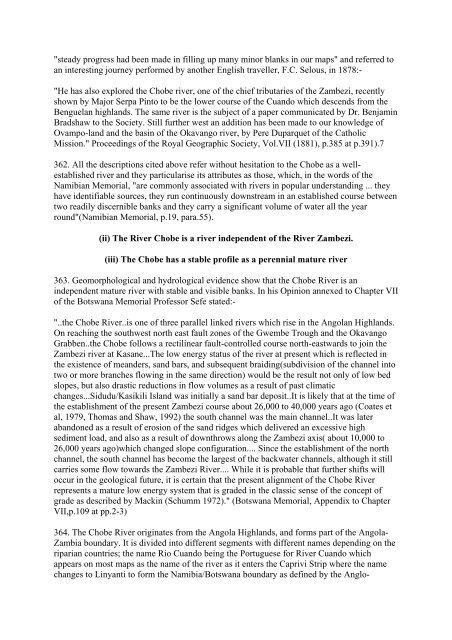botswana/namibia - Cour international de Justice
botswana/namibia - Cour international de Justice
botswana/namibia - Cour international de Justice
You also want an ePaper? Increase the reach of your titles
YUMPU automatically turns print PDFs into web optimized ePapers that Google loves.
"steady progress had been ma<strong>de</strong> in filling up many minor blanks in our maps" and referred to<br />
an interesting journey performed by another English traveller, F.C. Selous, in 1878:-<br />
"He has also explored the Chobe river, one of the chief tributaries of the Zambezi, recently<br />
shown by Major Serpa Pinto to be the lower course of the Cuando which <strong>de</strong>scends from the<br />
Benguelan highlands. The same river is the subject of a paper communicated by Dr. Benjamin<br />
Bradshaw to the Society. Still further west an addition has been ma<strong>de</strong> to our knowledge of<br />
Ovampo-land and the basin of the Okavango river, by Pere Duparquet of the Catholic<br />
Mission." Proceedings of the Royal Geographic Society, Vol.VII (1881), p.385 at p.391).7<br />
362. All the <strong>de</strong>scriptions cited above refer without hesitation to the Chobe as a wellestablished<br />
river and they particularise its attributes as those, which, in the words of the<br />
Namibian Memorial, "are commonly associated with rivers in popular un<strong>de</strong>rstanding ... they<br />
have i<strong>de</strong>ntifiable sources, they run continuously downstream in an established course between<br />
two readily discernible banks and they carry a significant volume of water all the year<br />
round"(Namibian Memorial, p.19, para.55).<br />
(ii) The River Chobe is a river in<strong>de</strong>pen<strong>de</strong>nt of the River Zambezi.<br />
(iii) The Chobe has a stable profile as a perennial mature river<br />
363. Geomorphological and hydrological evi<strong>de</strong>nce show that the Chobe River is an<br />
in<strong>de</strong>pen<strong>de</strong>nt mature river with stable and visible banks. In his Opinion annexed to Chapter VII<br />
of the Botswana Memorial Professor Sefe stated:-<br />
"..the Chobe River..is one of three parallel linked rivers which rise in the Angolan Highlands.<br />
On reaching the southwest north east fault zones of the Gwembe Trough and the Okavango<br />
Grabben..the Chobe follows a rectilinear fault-controlled course north-eastwards to join the<br />
Zambezi river at Kasane...The low energy status of the river at present which is reflected in<br />
the existence of mean<strong>de</strong>rs, sand bars, and subsequent braiding(subdivision of the channel into<br />
two or more branches flowing in the same direction) would be the result not only of low bed<br />
slopes, but also drastic reductions in flow volumes as a result of past climatic<br />
changes...Sidudu/Kasikili Island was initially a sand bar <strong>de</strong>posit..It is likely that at the time of<br />
the establishment of the present Zambezi course about 26,000 to 40,000 years ago (Coates et<br />
al, 1979, Thomas and Shaw, 1992) the south channel was the main channel..It was later<br />
abandoned as a result of erosion of the sand ridges which <strong>de</strong>livered an excessive high<br />
sediment load, and also as a result of downthrows along the Zambezi axis( about 10,000 to<br />
26,000 years ago)which changed slope configuration.... Since the establishment of the north<br />
channel, the south channel has become the largest of the backwater channels, although it still<br />
carries some flow towards the Zambezi River.... While it is probable that further shifts will<br />
occur in the geological future, it is certain that the present alignment of the Chobe River<br />
represents a mature low energy system that is gra<strong>de</strong>d in the classic sense of the concept of<br />
gra<strong>de</strong> as <strong>de</strong>scribed by Mackin (Schumm 1972)." (Botswana Memorial, Appendix to Chapter<br />
VII,p.109 at pp.2-3)<br />
364. The Chobe River originates from the Angola Highlands, and forms part of the Angola-<br />
Zambia boundary. It is divi<strong>de</strong>d into different segments with different names <strong>de</strong>pending on the<br />
riparian countries; the name Rio Cuando being the Portuguese for River Cuando which<br />
appears on most maps as the name of the river as it enters the Caprivi Strip where the name<br />
changes to Linyanti to form the Namibia/Botswana boundary as <strong>de</strong>fined by the Anglo-

















